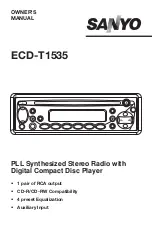
TANDBERG Maestro MXP
298
Restart:
Restarts the system.
Restore defaults:
Restores system settings to the factory defaults.
Restricted call:
A call to a 56 kbps network. By default the system will dial an unrestricted call (a
call to a 64 kbps network) and downspeed to 56 kbps if necessary.
S
S-VHS:
S-video
S-video:
The standard camera uses one of the S-video inputs in the codec.
Selfview:
Outgoing video. In most cases, this is the image of your self.
Serial number:
A unique number (the hardware serial number, listed in the System Information
menu) to identify your system towards your TANDBERG representatives.
Side-by-Side:
Side-by-side view means that two pictures are displayed side by side each other
on the screen. You will se two equally sized pictures.
SIF:
Standard Input Format, 352x240 pixels
SNMP:
Simple Network Management Protocol.
SNMP Community:
SNMP Community names are used to authenticate SNMP requests. SNMP
requests must have a password in order to receive a response from the SNMP agent in
the system. The SNMP Community name is case sensitive.
SNMP Trap Host:
Identifies the IP-address of the SNMP manager.
SNMP traps:
Generated by the agent to inform the manager about important events.
SoftMux:
Ensures high reliability and includes the unique Downspeeding feature. It also makes it
possible to dial to another videoconferencing equipment, phones and mobile phones in a
uniform way, and provides an on-screen, real-time feedback on the progress of a call.
Split Screen:
All the participants in a MultiSite conference are displayed on the screen. (Former
Continuous Presence)
Start Channel:
Indicates the firstE1/T1 channel the system is allowed to use. The setting might
be used when if the E1/T1 line is shared with other equipment.
Start up video source:
The video source that is on display when the system wakes up from
standby mode.
Status Format:
Provides call quality feedback on the status line.
Streaming:
Allows broadcasting of audio/video via an IP network.
Streaming Address:
Defined as the IP-address of a streaming client, streaming server or a
multicast address.
Streaming Address Port:
If several codecs are streaming to the same IP-address, different
ports have to be used in order for the client to know which stream to receive.
Streaming Allow remote Start:
Streaming can be started from the Videoconferencing system
using the remote control, by using the Data port, or from external user interfaces like the
Web-browser or Telnet session.
Streaming Announcements:
The system will announce to the network that it is streaming. This
enables a streaming client (e.g. a PC) to connect to the system's streaming session.
Used by Cisco IP/TV.
Streaming Password:
Prevents unauthorized access to the streaming functionality.
Summary of Contents for Maestro MXP
Page 24: ...TANDBERG Maestro MXP 24 Figure 3 ...
Page 26: ...TANDBERG Maestro MXP 26 6 PC Connect cable from DVI I in PC from the Codec to PC ...
Page 53: ...General Use 53 ...
Page 138: ...TANDBERG Maestro MXP 138 PC Presentation shown in Wide stretched mode ...
Page 194: ...TANDBERG Maestro MXP 194 Voice Switched mode ...
Page 247: ...Peripheral Equipment 247 ...
Page 253: ...Peripheral Equipment 253 ...
Page 280: ...TANDBERG Maestro MXP 280 Dimensions Front view Side view Rear view Underside view ...
Page 291: ...Glossary 291 6 16 Appendix 16 Declaration of Conformity ...





































